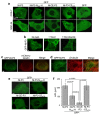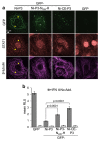Quantitative Analysis of the Microtubule Interaction of Rabies Virus P3 Protein: Roles in Immune Evasion and Pathogenesis
- PMID: 27649849
- PMCID: PMC5030706
- DOI: 10.1038/srep33493
Quantitative Analysis of the Microtubule Interaction of Rabies Virus P3 Protein: Roles in Immune Evasion and Pathogenesis
Abstract
Although microtubules (MTs) are known to have important roles in intracellular transport of many viruses, a number of reports suggest that specific viral MT-associated proteins (MAPs) target MTs to subvert distinct MT-dependent cellular processes. The precise functional importance of these interactions and their roles in pathogenesis, however, remain largely unresolved. To assess the association with disease of the rabies virus (RABV) MAP, P3, we quantitatively compared the phenotypes of P3 from a pathogenic RABV strain, Nishigahara (Ni) and a non-pathogenic Ni-derivative strain, Ni-CE. Using confocal/live-cell imaging and dSTORM super-resolution microscopy to quantify protein interactions with the MT network and with individual MT filaments, we found that the interaction by Ni-CE-P3 is significantly impaired compared with Ni-P3. This correlated with an impaired capacity to effect association of the transcription factor STAT1 with MTs and to antagonize interferon (IFN)/STAT1-dependent antiviral signaling. Importantly, we identified a single mutation in Ni-CE-P3 that is sufficient to inhibit MT-association and IFN-antagonist function of Ni-P3, and showed that this mutation alone attenuates the pathogenicity of RABV. These data provide evidence that the viral protein-MT interface has important roles in pathogenesis, suggesting that this interface could provide targets for vaccine/antiviral drug development.
Figures







Similar articles
-
Lyssavirus P Protein Isoforms Diverge Significantly in Subcellular Interactions Underlying Mechanisms of Interferon Antagonism.J Virol. 2022 Oct 26;96(20):e0139622. doi: 10.1128/jvi.01396-22. Epub 2022 Oct 12. J Virol. 2022. PMID: 36222519 Free PMC article.
-
Molecular Basis of Functional Effects of Phosphorylation of the C-Terminal Domain of the Rabies Virus P Protein.J Virol. 2022 May 11;96(9):e0011122. doi: 10.1128/jvi.00111-22. Epub 2022 Apr 11. J Virol. 2022. PMID: 35404083 Free PMC article.
-
Implication of the nuclear trafficking of rabies virus P3 protein in viral pathogenicity.Traffic. 2021 Dec;22(12):482-489. doi: 10.1111/tra.12821. Epub 2021 Oct 19. Traffic. 2021. PMID: 34622522
-
Subcellular trafficking in rhabdovirus infection and immune evasion: a novel target for therapeutics.Infect Disord Drug Targets. 2012 Feb;12(1):38-58. doi: 10.2174/187152612798994966. Infect Disord Drug Targets. 2012. PMID: 22034934 Review.
-
The importance of immune evasion in the pathogenesis of rabies virus.J Vet Med Sci. 2016 Aug 1;78(7):1089-98. doi: 10.1292/jvms.16-0092. Epub 2016 Apr 2. J Vet Med Sci. 2016. PMID: 27041139 Free PMC article. Review.
Cited by
-
The Effect of Permethrin Resistance on Aedes aegypti Transcriptome Following Ingestion of Zika Virus Infected Blood.Viruses. 2018 Sep 1;10(9):470. doi: 10.3390/v10090470. Viruses. 2018. PMID: 30200481 Free PMC article.
-
Rabies Virus Exploits Cytoskeleton Network to Cause Early Disease Progression and Cellular Dysfunction.Front Vet Sci. 2022 May 13;9:889873. doi: 10.3389/fvets.2022.889873. eCollection 2022. Front Vet Sci. 2022. PMID: 35685339 Free PMC article. Review.
-
Lyssavirus P Protein Isoforms Diverge Significantly in Subcellular Interactions Underlying Mechanisms of Interferon Antagonism.J Virol. 2022 Oct 26;96(20):e0139622. doi: 10.1128/jvi.01396-22. Epub 2022 Oct 12. J Virol. 2022. PMID: 36222519 Free PMC article.
-
Structural Determination of the Australian Bat Lyssavirus Nucleoprotein and Phosphoprotein Complex.Viruses. 2023 Dec 23;16(1):33. doi: 10.3390/v16010033. Viruses. 2023. PMID: 38229694 Free PMC article.
-
Nanoscale characterization of drug-induced microtubule filament dysfunction using super-resolution microscopy.BMC Biol. 2021 Dec 11;19(1):260. doi: 10.1186/s12915-021-01164-4. BMC Biol. 2021. PMID: 34895240 Free PMC article.
References
Publication types
MeSH terms
Substances
LinkOut - more resources
Full Text Sources
Other Literature Sources
Medical
Research Materials
Miscellaneous

